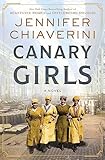Wednesday, July 10, 2024
CANARY GIRLS by Jennifer Chiaverini
Helen’s husband, Arthur Purcell, is managing one of his
industrialist family’s manufacturing plants, which has been converted from a
sewing machine factory to a munitions arsenal.
World War I has just broken out, and Lucy’s husband, Daniel, an
architect and star footballer (soccer player) has joined a British infantry
regiment. April is a former domestic
servant who goes to work in the Purcell factory’s Danger Building, loading
fuses with TNT. Lucy obtains a more
skilled position at the same factory, and they become teammates on the
company’s women’s football team. Helen,
who becomes a liaison between management and the many women working in her
husband’s factory, soon discovers that handling TNT is a health hazard for the
workers and gives their skin a yellow tint.
Hence, the moniker “canary girls.”
Respiratory issues are an even bigger problem, and Helen does what she
can to improve the safety of the workers.
At the top of the hazards list, however, is the risk of an explosion,
and no metal objects or incendiary materials are allowed in the building. This novel follows the lives of these three
women in particular but the plight of the canary girls in general. They bond on the football pitch and share in
their concerns for one another’s health and welfare, but they continue to work
under these conditions because the money is better than anything they can find
anywhere else. Also, they seem to have a
genuine desire to contribute to the war effort and an appreciation for the
essential nature of their jobs. I did
not revel in the prose here, but the novel moves at a pretty brisk pace and
gave me an in-depth look at the circumstances that kept the canary girls
working in an unsafe and unhealthy setting.
Subscribe to:
Post Comments (Atom)

No comments:
Post a Comment